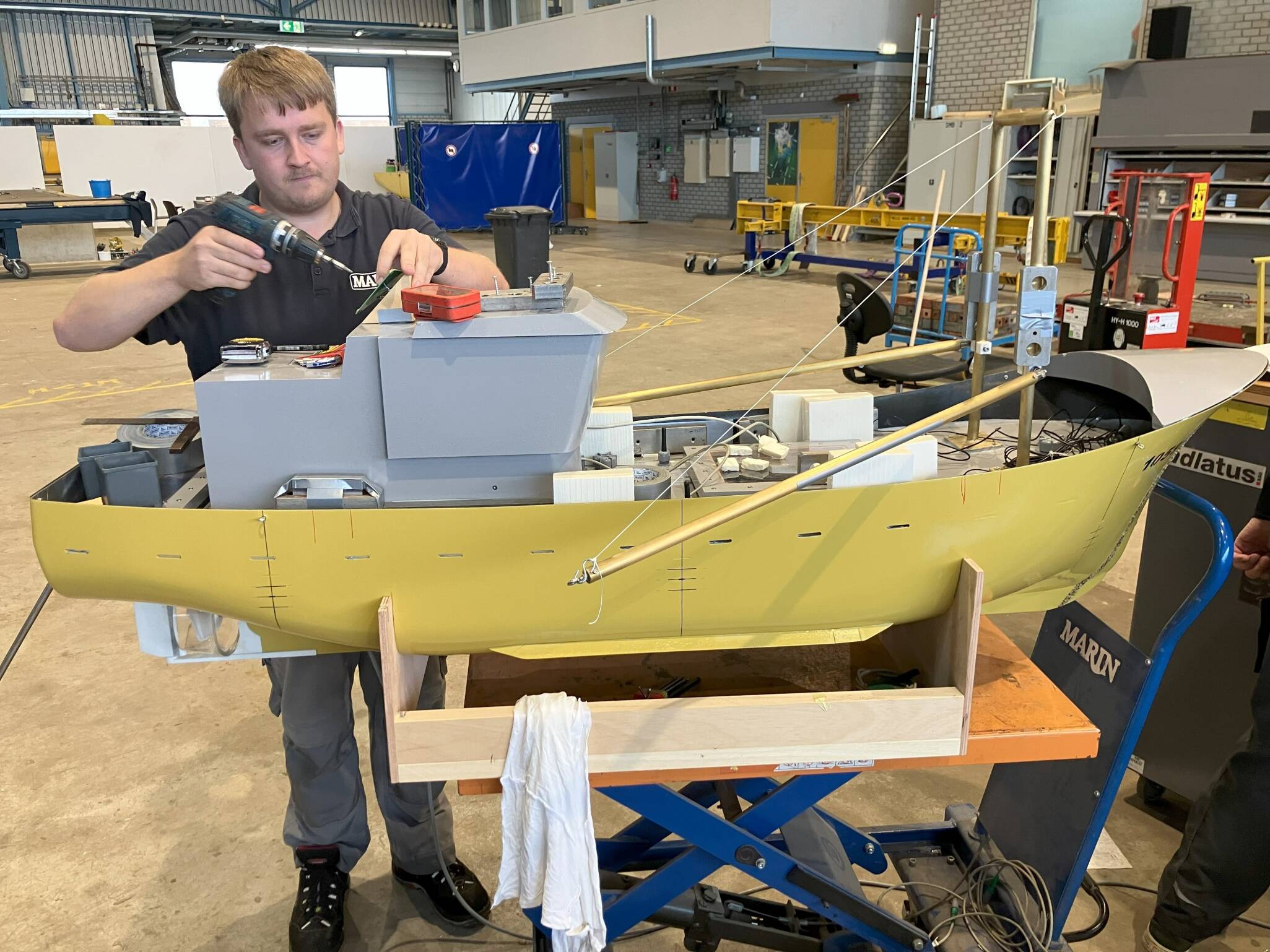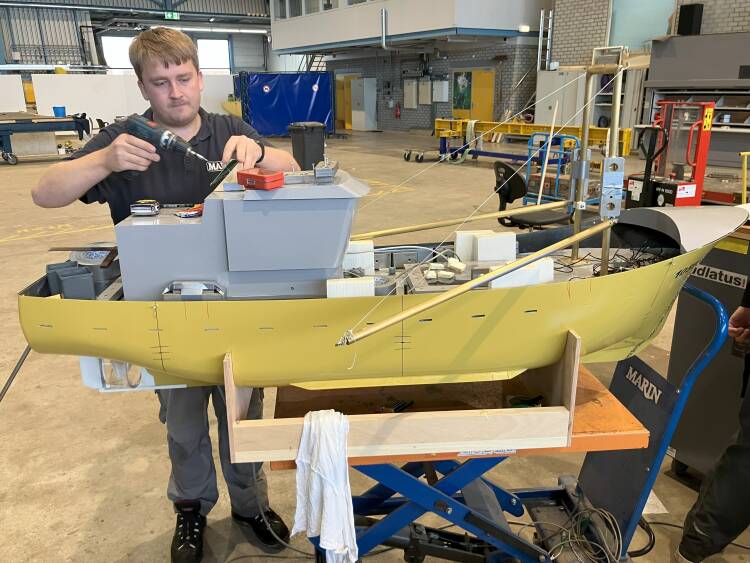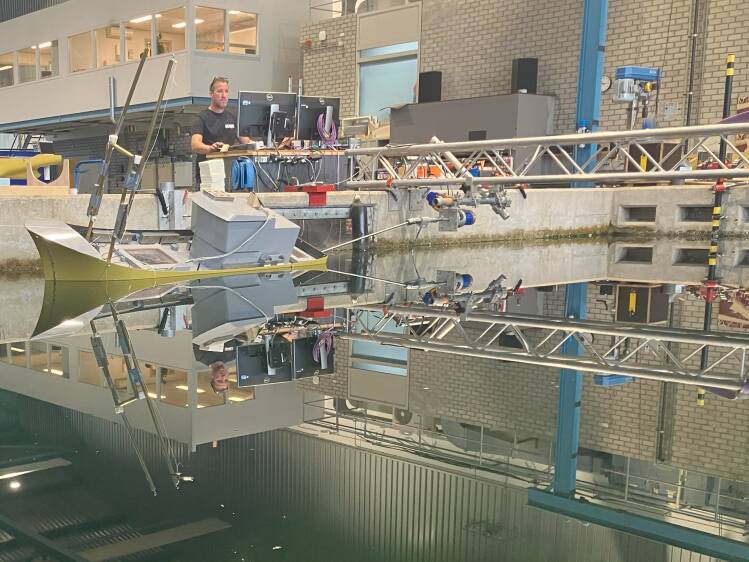December 2024, no. 142
Test in irregular beam seas.
Preparations for stability measurements.

Interested? Contact us to discuss your options
Create a MARIN account to stay updated





Report
Dutch government study examining the stability of beam trawlers
The Dutch Ministry of Infrastructure and Water Management has contracted MARIN to study the dynamics of capsizing beam trawlers in more detail.
Previous studies carried out following the sinking of the UK 165 and UK 171 indicated that asymmetric conditions are particularly risky, such as losing fishing gear or getting stuck on one side. Conoship recommended additional stability requirements on that basis.
For the study on stability, a remote-controlled model of a generic cutter with an open aft deck and an overall length of 24 m was made. Earlier research demonstrated that this vessel type was more vulnerable than larger fishing vessels regarding stability issues. The superstructure, bulwarks, booms and weight distribution were modelled to scale.

Model being prepared for tests.

Furthermore, we will fit the tuned digital model into the Large Motion Simulator to use the acquired knowledge to train fishermen and students.
Training with a digital model
Based on the results of the tests, we are tuning the existing simulation model of the cutter to make its behaviour more similar to the test results. This model can be used for assessing the capsize risk in more detail and over longer durations than what was possible in the basin tests, to evaluate the necessity of additional stability criteria.
Furthermore, we will fit the tuned digital model into the Large Motion Simulator to use the acquired knowledge to train fishermen and students. This will increase their insight into the stability of fishing vessels and how to find and test mitigating measures when asymmetric conditions arise, ultimately preventing capsizing disasters.
Extreme wave tests
To test the dynamic stability, we sailed the model in extreme waves with different asymmetric conditions, where the wind force was applied to the model by means of a winch. During the tests, the model capsized several times in conditions where the ship did not meet the applicable stability requirements. As expected, the range of positive stability, and area below the GZ curve, was an important parameter for the capsize risk.
The measured results are being processed and analysed. During the evaluation of the capsize risk it is important to keep in mind that the duration of the model test resembles roughly half an hour full-scale time, whereas the vessel will sail for half a century. The process of capsizing is non-linear and cannot be extrapolated based on these statistic results alone.
Asymmetric loading conditions
The stability criteria give requirements for the stability curve, also known as the GZ curve. Therefore, we accurately modelled and measured the stability curve up to the heel angle at which the vessel capsized. This was accomplished by modelling the buoyancy of the superstructure. To measure the righting moment for a large range of heel angles, we built a dedicated test setup using a fin servo, cardan shaft and torque sensor. The GZ curve was measured for each of the asymmetric conditions tested.
The rules, based on the GZ curve, make sure that the vessel can withstand a substantial amount of energy due to wind and wave loading. However, dynamic effects due to roll damping, the effect of water on deck and breaking waves are not included.
December 2024, no. 142
Test in irregular beam seas.
Training with a digital model
Based on the results of the tests, we are tuning the existing simulation model of the cutter to make its behaviour more similar to the test results. This model can be used for assessing the capsize risk in more detail and over longer durations than what was possible in the basin tests, to evaluate the necessity of additional stability criteria.
Furthermore, we will fit the tuned digital model into the Large Motion Simulator to use the acquired knowledge to train fishermen and students. This will increase their insight into the stability of fishing vessels and how to find and test mitigating measures when asymmetric conditions arise, ultimately preventing capsizing disasters.

Furthermore, we will fit the tuned digital model into the Large Motion Simulator to use the acquired knowledge to train fishermen and students.
Extreme wave tests
To test the dynamic stability, we sailed the model in extreme waves with different asymmetric conditions, where the wind force was applied to the model by means of a winch. During the tests, the model capsized several times in conditions where the ship did not meet the applicable stability requirements. As expected, the range of positive stability, and area below the GZ curve, was an important parameter for the capsize risk.
The measured results are being processed and analysed. During the evaluation of the capsize risk it is important to keep in mind that the duration of the model test resembles roughly half an hour full-scale time, whereas the vessel will sail for half a century. The process of capsizing is non-linear and cannot be extrapolated based on these statistic results alone.

Model being prepared for tests.
Preparations for stability measurements.

Interested? Contact us to discuss your options
Asymmetric loading conditions
The stability criteria give requirements for the stability curve, also known as the GZ curve. Therefore, we accurately modelled and measured the stability curve up to the heel angle at which the vessel capsized. This was accomplished by modelling the buoyancy of the superstructure. To measure the righting moment for a large range of heel angles, we built a dedicated test setup using a fin servo, cardan shaft and torque sensor. The GZ curve was measured for each of the asymmetric conditions tested.
The rules, based on the GZ curve, make sure that the vessel can withstand a substantial amount of energy due to wind and wave loading. However, dynamic effects due to roll damping, the effect of water on deck and breaking waves are not included.
Previous studies carried out following the sinking of the UK 165 and UK 171 indicated that asymmetric conditions are particularly risky, such as losing fishing gear or getting stuck on one side. Conoship recommended additional stability requirements on that basis.
For the study on stability, a remote-controlled model of a generic cutter with an open aft deck and an overall length of 24 m was made. Earlier research demonstrated that this vessel type was more vulnerable than larger fishing vessels regarding stability issues. The superstructure, bulwarks, booms and weight distribution were modelled to scale.
The Dutch Ministry of Infrastructure and Water Management has contracted MARIN to study the dynamics of capsizing beam trawlers in more detail.
Dutch government study examining the stability of beam trawlers
Create a MARIN account to stay updated





Report






